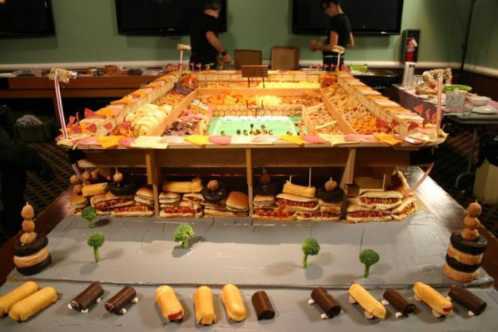Nuffnang
TOP 10 MOST BEAUTIFUL FEMALE BOXERS
10.Mia Rosales St. John is a Mexican-American professional boxer in the Light Welterweight division. Mia is the former WIBA and WIBF Lightweight Champion.[1] She is also a model, businesswoman, and Tae Kwon Do Champion
09. Yesica Yolanda Bopp, born April 11, 1984 in Villa Domínico is a women's boxing champion in the light flyweight division. Nicknamed "Tuti," Bopp stands 5'0" tall and has a perfect professional record of 19-0.
She won the interim WBA Female light flyweight title on December 4, 2008 after defeating Ana Fernandez, and she has made eight successful defenses. Bopp is also the reigning WBO Female light flyweight titleholder, having won that belt on November 6, 2009. She successfully defended it against Carina Moreno on January 29, 2011, and followed that up with five more victories in 2011.
08. Frida Wallberg born April 28, 1983 in Åtvidaberg in Östergötland, Sweden. Wallberg is Sweden's most successful female boxer. As an amateur, she won 48 of 53 games before she turned pro in 2004. She has won the Nordic championship two times and the Swedish championship six times and is currently in the lightweight champion of WIBF.
27 November 2010 Frida defeated the Canadian boxer Olivia Gerula, which meant that Frida Wallberg took over the coveted WBC belt.
07. Cecilia Brækhus (born 28 September 1981 in Cartagena, Colombia) is a 1.71 m (5 ft 7 in) and 66 kilograms (150 lb), professional Norwegian boxer and a former kickboxer. She is currently the World Champion in Welterweight in the World Boxing Association, World Boxing Council, World Boxing Organization and World Professional Boxing Federation. She currently resides in Berlin, Germany.
06. Eva Ulrika Birgitta Wahlström (born October 30, 1980 in Loviisa) is the most successful Finnish female boxer to date. She was ranked second best in Europe in 2004 and 2005. She also made an appearance as a personal trainer to contestants (spring 2006 and autumn 2007 seasons) in Finnish reality television series Suurin pudottaja, a Finnish version of The Biggest Loser, with swimmer Jani Sievinen.
05. Ina Menzer was born in Atbasar, Khazakhstan on November 10 1980.In the 60-kg division at the first German Women's Amateur Championships in Meppen, Germany in November 2003, Ina defeated Diana Meindl of BC Schwandorf by a 36-12 margin in the semifinal, then bested Carmen Falke of VfK Celle by 27-14 in the final.
04. Ana Julaton (born Luciana Bonifacio Julaton, 5 July 1980) is the first Filipino American boxer to win the Women's WBO Super Bantamweight and IBA Super Bantamweight titles. Nicknamed “The Hurricane,” she is also one of the “quickest” boxers ever to win a world title, having fought only five other professional bouts before winning the IBA Super Bantamweight title
03. Laila Ali was named Super Middleweight Champion by the International Boxing Association in 2002 and Super Middleweight Champion by International Women's Boxing Federation in 2005.
02. Regina Halmich (born November 22, 1976) is a popular female boxer from Germany. Halmich is among the most successful female boxers of all time, and helped popularize female boxing in Europe.
01. Melinda "La Maravilla" Cooper, born in Las Vegas, Nevada on March 6, 1985, was the WIBA[1] and IBA Flyweight Champion of the world, and is recognized as one of the elite female professional boxers on the planet.
Cooper started boxing in 1996, after meeting trainer James Pena at the Nevada Partners gym in Las Vegas. Pena recalls that at first he did not realize that Cooper was a girl, because she was with three boys and the hood of her coat was over her head. "There were a group of kids there, and I asked them all if they wanted to box, but no one really wanted to. Then I asked Melinda, 'How about you?' and she said she'd try it. It wasn't until the next day I realized she was a girl." "I told her, `Oh, sweetheart, I can't let you box. You're a girl. I can't let you box with the boys.' But she said she wanted to try and box them." She lasted four rounds that first day, and made an impression on Pena, who had never trained a female before. "I told her, `If you want to box, show up at 3:30 and don't be late. Every day since, she's showed up at 3:30." Pena later became Cooper's legal guardian.
Fantastic Super Mario Inspired Artwork
For over 20 years, Super Mario Bros. was the best-selling video game of all time (before being outsold by Nintendo's own Wii Sports in 2009), and has sold more than 40 million copies worldwide. As a launch title, it was largely responsible for the initial success of the Nintendo Entertainment System, as well as ending the two-year slump of console game sales in the United States after the video game crash of 1983. As one of Shigeru Miyamoto and Takashi Tezuka's most influential early successes, it has inspired many clones, sequels, and spin-offs. The game's theme music by Koji Kondo is recognized worldwide, even by those who have not played the game, and has been considered a representation for video game music in general.
Green Fireball Phenomenon
Green fireballs are a type of unidentified flying object which have been sighted in the sky since the late 1940s. Early sightings primarily occurred in the southwestern United States, particularly in New Mexico. They were once of notable concern to the US government because they were often clustered around sensitive research and military installations, such as Los Alamos and Sandia National Laboratory, then Sandia base.
Meteor expert Dr. Lincoln LaPaz headed much of the investigation into the fireballs on behalf of the military. LaPaz's conclusion was that the objects displayed too many anomalous characteristics to be a type of meteor and instead were artificial, perhaps secret Russian spy devices. The green fireballs were seen by many people of high repute including LaPaz, distinguished Los Alamos scientists, Kirtland AFB intelligence officers and Air Command Defense personnel. A February 1949 Los Alamos conference attended by aforementioned sighters, Project Sign, world renowned upper atmosphere physicist Dr. Joseph Kaplan, H-bomb scientist Dr. Edward Teller, other scientists and military brass concluded, though far from unanimously, that green fireballs were natural phenomena. To the conference attendees, only the green fire ball source was unknown, their existence was unquestioned. Secret conferences were convened at Los Alamos to study the phenomenon[citation needed] and in Washington by the U.S. Air Force Scientific Advisory Board.
In December 1949 Project Twinkle, a network of green fireball observation and photographic stations, was established but never fully implemented. It was discontinued two years later, with the official conclusion that the phenomenon was probably natural in origin.
Green fireballs have been given natural, man-made, and extraterrestrial origins and have become associated with both the Cold War and ufology. Because of the extensive government paper trail on the phenomenon, many ufologists consider the green fireballs to be among the best documented examples of unidentified flying objects (UFOs).
Meteor expert Dr. Lincoln LaPaz headed much of the investigation into the fireballs on behalf of the military. LaPaz's conclusion was that the objects displayed too many anomalous characteristics to be a type of meteor and instead were artificial, perhaps secret Russian spy devices. The green fireballs were seen by many people of high repute including LaPaz, distinguished Los Alamos scientists, Kirtland AFB intelligence officers and Air Command Defense personnel. A February 1949 Los Alamos conference attended by aforementioned sighters, Project Sign, world renowned upper atmosphere physicist Dr. Joseph Kaplan, H-bomb scientist Dr. Edward Teller, other scientists and military brass concluded, though far from unanimously, that green fireballs were natural phenomena. To the conference attendees, only the green fire ball source was unknown, their existence was unquestioned. Secret conferences were convened at Los Alamos to study the phenomenon[citation needed] and in Washington by the U.S. Air Force Scientific Advisory Board.
In December 1949 Project Twinkle, a network of green fireball observation and photographic stations, was established but never fully implemented. It was discontinued two years later, with the official conclusion that the phenomenon was probably natural in origin.
Green fireballs have been given natural, man-made, and extraterrestrial origins and have become associated with both the Cold War and ufology. Because of the extensive government paper trail on the phenomenon, many ufologists consider the green fireballs to be among the best documented examples of unidentified flying objects (UFOs).
Photos by environmentalgraffiti.com
3,000 Ancient Buddhas Unearthed in China
Handan, China -- Archaeologists unearthed nearly 3,000 Buddha statues, which could be up to 1,500 years old.
The discovery is believed to be the largest of its kind since the founding of the People's Republic of China in 1949, an archaeologist with the Chinese Academy of Social Sciences told.
The Buddha statues most of which are made of white marble and limestone and many of which are broken could date back to the Eastern Wei and Northern Qi dynasties (A.D. 534 to 577), experts say.
The statues discovered during a dig outside of Ye, the ancient capital of the Eastern Wei and Northern Qi dynasties may have been rounded up and buried after the fall of the Northern Qi dynasty by later emperors in an attempt to purge the country of Buddhism.
In some cases, the Buddhist statues may have been buried by the faithful themselves in times of danger.
Japanese Manhole Covers
Japanese manhole covers, which come in a variety of designs depending on locality, utility type and the manufacturer of the manhole cover, have caught the imagination of a growing number of "drainspotters" from around the world.
A quick search on Google reveals the increasing number of tribute sites and the popularity of the cult of the manhole.
Japan's manhole covers often include a symbol specific to an area or town as part of the overall design. In Kyoto, a turtle (a symbol of wisdom and longevity) is the main motif, in addition local landmarks, festivals or flora and fauna can all be incorporated into these works of art under our feet.
Via kuriositas.com
A quick search on Google reveals the increasing number of tribute sites and the popularity of the cult of the manhole.
Japan's manhole covers often include a symbol specific to an area or town as part of the overall design. In Kyoto, a turtle (a symbol of wisdom and longevity) is the main motif, in addition local landmarks, festivals or flora and fauna can all be incorporated into these works of art under our feet.
Via kuriositas.com
Subscribe to:
Comments (Atom)

































































